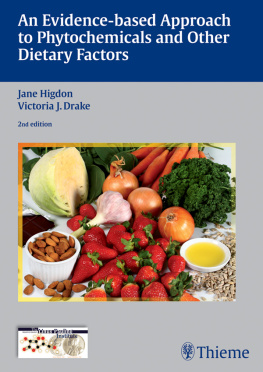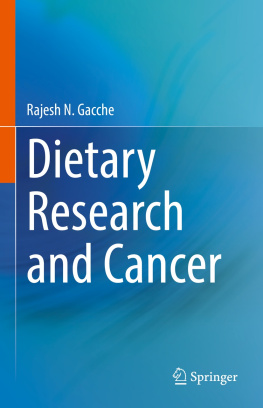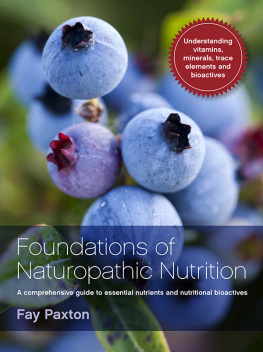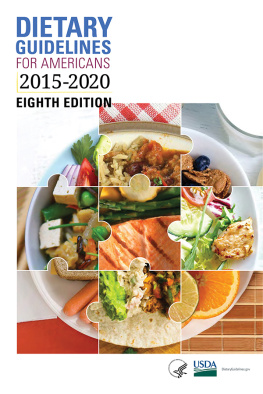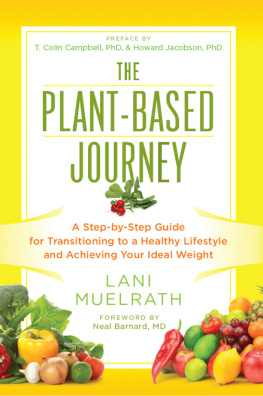An Evidence-based Approach to Phytochemicals and Other Dietary Factors
Jane Higdon, PhD
Linus Pauling Institute
Oregon State University
Corvallis, Oregon, USA
Victoria J. Drake, PhD
Manager
Micronutrient Information Center
Linus Pauling Institute
Oregon State University
Corvallis, Oregon, USA
2nd edition
33 illustrations
Thieme
Stuttgart New York
Library of Congress Cataloging-in-Publication Data is available from the publisher.
1st English Edition 2007
2013 Georg Thieme Verlag KG,
Rdigerstrasse 14,
70469 Stuttgart, Germany
http://www.thieme.de
Thieme Medical Publishers, Inc.,
333 Seventh Avenue,
New York, NY 10001, USA
http://www.thieme.com
Cover design: Thieme Publishing Group
Typesetting by primustype Robert Hurler GmbH,
Notzingen, Germany
Printed in Germany by GCC graphisches
Centrum Cuno, Calbe (Saale)
ISBN 978-3-13-141842-5
eISBN 978-3-13-169712-7
Important note: Medicine is an ever-changing science undergoing continual development. Research and clinical experience are continually expanding our knowledge, in particular our knowledge of proper treatment and drug therapy. Insofar as this book mentions any dosage or application, readers may rest assured that the authors, editors, and publishers have made every effort to ensure that such references are in accordance with the state of knowledge at the time of production of the book.
Nevertheless, this does not involve, imply, or express any guarantee or responsibility on the part of the publishers in respect to any dosage instructions and forms of applications stated in the book.
Every user is requested to examine carefully the manufacturers leaflets accompanying each drug and to check, if necessary in consultation with a physician or specialist, whether the dosage schedules mentioned therein or the contraindications stated by the manufacturers differ from the statements made in the present book. Such examination is particularly important with drugs that are either rarely used or have been newly released on the market. Every dosage schedule or every form of application used is entirely at the user's own risk and responsibility. The authors and publishers request every user to report to the publishers any discrepancies or inaccuracies noticed. If errors in this work are found after publication, errata will be posted at www.thieme.com on the product description page.
Some of the product names, patents, and registered designs referred to in this book are in fact registered trademarks or proprietary names even though specific reference to this fact is not always made in the text. Therefore, the appearance of a name without designation as proprietary is not to be construed as a representation by the publisher that it is in the public domain.
This book, including all parts thereof, is legally protected by copyright. Any use, exploitation, or commercialization outside the narrow limits set by copyright legislation, without the publisher's consent, is illegal and liable to prosecution. This applies in particular to photostat reproduction, copying, mimeographing, preparation of microfilms, and electronic data processing and storage.
Foreword
Accuse not Nature!
She has done her part;
Do thou but thine!
John Milton, Paradise Lost, 1667
Archeology reveals that ancient peoples recognized that certain foods could promote health and treat disease. The use of decoctions, distillates, extracts, and infusions of plant foods, spices and related botanicals in apothecary, Ayurvedic, Chinese, Native American, and other traditional medicines reflects the early application of this knowledge regarding their bioactive constituents. Today, exciting advances in nutrition and medicine, as well as numerous reports in popular books and the media, have stimulated a general interest in phytochemicals and other dietary factors. New recipes emphasizing phytochemical-rich dishes, common foods fortified with these functional ingredients, and dietary supplements formulated with a variety of these compounds seem to be appearing every month. However, this profusion of choices is often accompanied by confusion about their efficacy and safety. Thus, the need for ready access to sound, evidence-based science by consumers and health-care professionals is more critical than ever before.
We now appreciate that our evolution in a world of edible plants allowed our bodies not only to forego the energy necessary for synthesizing many critical compounds (that we now call essential nutrients) but also to take advantage of other natural constituents in these foods beyond their provision of basic nutritive value. For example, it is interesting to note how our retina employs the carotenoid lutein to filter phototoxic blue light and near-ultraviolet radiation in the same way that lutein protects the plants from which we obtain it. Nutrition scientists are now working to understand the enormous complexity and health implications of thousands of phytochemicals and other dietary factors, including their bioavailability, distribution, metabolism, excretion, mechanisms of action, and interactions with one another within individual foods and whole diets. It is worth noting that research indicates that many of these compounds have the potential to influence the expression of mammalian genes, suggesting phytochemicals can influence fundamental aspects of our cellular function, despite their not being essential to us. It can appear an overwhelming challenge to document the myriad of fruits, grains, legumes, nuts, seeds, and vegetables and the ways in which they serve to support our physical well being and our mental state. However, the first publication of this book by Dr. Jane Higdon, now updated by Dr. Victoria Drake in this second edition, makes this task much easier by providing a concise synthesis of the basic, observational, and clinical data now available and organizing the material in a practical fashion both by foods and by bioactive constituents and their applications to health promotion and therapy.
The worldwide, demographic imperative of the aging population is readily reflected in the shift during the last century from a situation where most mortality resulted from communicable diseases to one where mortality is more often a result of chronic disease. The promise of the power of nutrition lies in our being able to understand the benefits offered not only by essential macronutrients and micronutrients but by other dietary factors, especially phytochemicals like carotenoids, chlorophylls, glucosinolates, organosulfurs, phytosterols, and polyphenols, as well compounds like -lipoic acid, L-carnitine, choline, and ubiquinone (coenzyme Q10) All of these compounds, and the foods that contain them, are described in this book. In addition to their own expertise, Drs. Higdon and Drake have ensured the accuracy of this material by having each chapter reviewed by an authority in that field.
The application of this knowledge about phytochemicals and other dietary factors will provide a sound foundation for new dietary guidelines and also the requisite scientific substantiation for the development of new food products, sometimes called designer foods, functional foods, pharmafoods, or nutraceuticals, as well as for dietary supplements. However, a great deal more research must still be done to demonstrate not only the efficacy but also the safety of these ingredients and how they are formulated into new products that offer to enhance our biological defense mechanisms, promote optimal physiological responses, reduce the risk of specific diseases, and even slow the processes associated with aging. While regulations concerning labeling and claims of benefit made for food products seem often to be controversial, there is no doubt that evaluating the emerging scientific information with sound judgment, as is done in this book, will help health-care providers, especially dietitians, nurses, and physicians, apply it today and allow policymakers and researchers to plan for the future in a rational manner.
Next page
